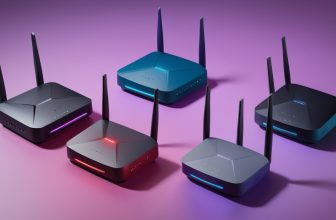Why Securing Your Router Is Step One for a Safe Home Network
Your router isn’t just another gadget — it’s the front door to your entire digital life. Everything that touches the internet in your house goes through it: your phones, cameras, laptops, smart doorbells… all of it. The problem? A lot of routers ship with weak default passwords and rarely get updates, which makes them a hacker’s dream.
Staying secure doesn’t have to mean becoming paranoid — it just means picking a router that’s got your back. Look for ones with strong encryption, automatic firmware updates, and easy-to-manage security settings.
In this guide, I’ll break down three types of users so you can find your perfect match:
🔒 The Privacy Protector — built-in VPN and hardened defaults.
⚙️ The Power User — advanced controls, traffic segmentation, and intrusion protection.
🛡️ The Set-It-and-Forget-It type — automatic updates and simple recovery when things go wrong.
Whatever your setup, one smart choice at the router level keeps everything else safe — and that’s peace of mind worth having.
Privacy-First Pick: Strong Defaults + Built-In VPN Protection
This type of router isn’t chasing bragging rights for speed — it’s built for people who want their home network locked down tight without messing with settings every week. Think of it as the digital version of tinted windows, a heavy-duty deadbolt, and motion lights. You don’t really notice it’s there… until something tries to mess with your privacy.
With hardened defaults and a VPN built right in, this is the router profile that quietly keeps your devices protected while you go about your day.
Which Built‑In Features Actually Matter (And how to check them)
When you unbox a privacy-first router, walk through these checks right away:
- Default admin lockout: ensure remote/admin access is off by default and that the router supports account lockout or rate limiting after failed logins. To verify: log in locally, go to Administration → Remote Management and confirm it’s disabled; look for “Login Attempts” or “Brute‑force protection” settings.
- WPA3: enable the strongest Wi‑Fi encryption available. Check Wireless → Security and select WPA3 or WPA2/WPA3 mixed mode if some devices are older.
- Guest network isolation: turn the guest SSID on and enable “Access Intranet/Client Isolation” so guest devices can’t see your printers or NAS.
- DNS over TLS/HTTPS: switch DNS to a provider that supports encrypted DNS (Cloudflare, Quad9, NextDNS). Look under LAN → DNS or Security → DNS over TLS/HTTPS.
- Built‑in VPN client/server: verify the router ships with OpenVPN/WireGuard support so you can tunnel outbound traffic or accept connections back to your home network.
Quick how‑to: enable the essentials during setup
- Change the admin username/password and enable two-factor admin if available.
- Turn on automatic firmware updates (or at least enable update notifications).
- Enable WPA3 or mixed mode on your 2.4/5 GHz SSIDs.
- Create a guest SSID and toggle client isolation.
- Configure DNS over TLS/HTTPS to an encrypted resolver.
- Import or set up a VPN client profile (WireGuard/OpenVPN) or enable the VPN server if you need remote access.
Practical tradeoffs to expect
- VPN tunneling will reduce top throughput—expect 20–60% lower speeds depending on CPU and protocol (WireGuard is usually faster than OpenVPN).
- The initial setup takes a bit more time than a “plug‑and‑play” router, especially if you generate keys or import config files.
- Some older devices may not support WPA3 and might need a separate legacy SSID (avoid leaving legacy networks open).
Who This Setup Helps — And What to Watch Out For
This kind of setup is perfect for privacy-focused homes, remote workers who need their work laptop running through a secure VPN tunnel, and frequent travelers who want their smart-home gadgets talking back to a network they actually trust — not some random hotel Wi-Fi.
Just avoid the classic mistakes: don’t leave WPS turned on, don’t recycle weak passwords, don’t expose your router’s admin page to the whole internet, and definitely don’t turn off encryption just to squeeze a little more speed.
And here’s a pro move: test your remote access or VPN setup before you hit the road. The last thing you want is to be locked out of your own network when you’re halfway across the country.
Power-user Pick: Advanced Network Segmentation and Intrusion Protection
If you like the idea of business-style controls without hiring a sysadmin, this is the category for you. These routers give you VLANs/SSID segmentation, built‑in IDS/IPS, app filtering and readable logs so you can both lock down and understand what’s happening on your network.
Segmentation: VLANs vs SSIDs and a simple design you can copy
VLANs give the cleanest separation (works across wired and wireless); multiple SSIDs are fine if you only need Wi‑Fi splits. Here’s a straightforward layout:
- Trusted: wired work PC, NAS, printers — full internet access, minimal inbound allowed.
- Family: phones/tablets — general internet, access to printers but not NAS.
- Kids: tablets/phones with parental controls and time limits.
- IoT: cameras, smart plugs, bulbs — no access to Trusted or Family; only outbound to internet and any cloud endpoints required.
- Guest: internet only, client isolation on.
- Home Lab (optional): devices you want reachable from Trusted but isolated from IoT/Guest.
How to limit cross‑segment access: disable inter‑VLAN routing by default; create explicit firewall rules that allow Trusted → Home Lab for management, but deny IoT → Trusted. Use policy-based rules keyed to IP ranges or VLAN IDs.
IDS/IPS: keeping threats visible without drowning in alerts
Start IDS/IPS in detection-only mode for a week so you can see what would be blocked. Then:
- Enable only high‑confidence signature sets first (malware, C2, exploit attempts).
- Add protocol anomalies (DPI) cautiously — they often hit smart‑device quirks.
- Whitelist benign local services (your NAS, camera update server) to reduce false positives.
- Send logs to a syslog server or Home Assistant for searchable records and clearer alerts.
A practical tip: WireGuard traffic and some VPN tunnels can look like encrypted C2; add those endpoints to allowed lists to avoid noise.
Performance vs. Ease of Use — What You’re Really Trading
When a router runs things like deep packet inspection or intrusion protection, it’s basically doing extra homework in the background. That takes CPU power, which means you might see a little drop in top-end speed or a bit more lag when your network is under heavy load.
If you want the best of both worlds, look for routers with hardware acceleration or a dedicated security chip — reviews will usually show the CPU specs and “IPS throughput” numbers so you can tell how well it handles the extra security work.
And don’t forget the interface. A good router won’t bury you in nerdy hex dumps — it’ll give you a clean app or dashboard where you can flip features on and off with a tap and actually understand the alerts it sends you.
Who Should Pick This & Quick Troubleshooting
Best for power users, home labbers, and families who want granular oversight.
Common fixes when segmentation breaks devices:
- Device discovery (Chromecast, printers): enable mDNS reflector or use a controlled rule to allow multicast between specific VLANs.
- Gaming NAT problems: open required ports or place the console temporarily in a permitted VLAN/DMZ.
- Smart device pairing fails: briefly allow IoT→Trusted for setup, then lock it down and revoke access.
- If IDS blocks legit traffic: check detection logs, whitelist destination IPs or disable the specific signature.
These steps get you enterprise‑grade protection at home without living in the router UI.
Set It And Forget It Pick: Automatic Updates & Easy Recovery
What You Get Right Out of the Box
Routers in this category are built for people who don’t want to dig through 50 menus just to stay safe. They automatically pull in security updates, start off with solid default settings (WPA3 or WPA2-AES, unique admin password required, remote access turned off), and usually include a simple “flip-the-switch” filter that blocks sketchy websites and malware.
You’ll see this kind of setup on systems like the Eero Pro, Google Nest Wifi Pro, and TP-Link Deco. These are routers made for normal households — clean apps, clear options, and no technical gymnastics required to keep the bad guys out.
Quick setup walkthrough (do this first)
- Enable automatic updates in the app or web UI.
- Create your Wi‑Fi and change the default admin password.
- Add a Guest network and give it a clear name (e.g., “Guest‑Home”); enable client isolation.
- Turn on device‑level malware/URL filtering or “advanced security” feature.
- Save a backup of your router settings (system → backup/export); store the file somewhere safe.
Real‑world benefits
- You’re automatically patched for known vulnerabilities — no research or manual downloads.
- Guests get easy access without exposing your main devices.
- Malware/URL blocking usually stops drive‑by infections and prevents risky sites on kids’ devices.
- A saved settings backup means recovery takes minutes, not hours.
Practical limits and what to do if an automatic update breaks things
Convenience trades off with advanced customization: some settings or third‑party firmware options won’t be available. If an automatic update causes issues:
- Check the vendor’s app for a “rollback” or firmware history option.
- Restore the settings backup you saved earlier.
- If that fails, factory‑reset the router and restore the backup or reconfigure from scratch.
- Contact vendor support (screenshots and timestamps help) — many vendors can push fixes quickly.
Who Benefits Most?
- Busy households and parents who don’t want nightly admin tasks.
- Less technical users who still want modern protections.
- Anyone who prefers predictable, vendor‑managed security over DIY complexity.
One‑page “keep it secure” monthly routine
- Verify automatic updates are enabled.
- Check for unusual unknown devices on the client list.
- Review guest network usage and delete stale guest access.
- Export a fresh settings backup after any significant change.
- Glance at malware/blocking logs for blocked threats.
With these simple steps you get strong protection with minimal fuss — next, we’ll pull everything together to help you pick the right secure router for your needs.
⚡WiFi Guys Take
There’s no “one-size-fits-all” router when it comes to security — it really depends on how you use your home network. If you want maximum privacy with as little fuss as possible, go for the privacy-first model with built-in VPN and tougher defaults. If you like having full control over every corner of your network, the power-user model with segmentation and IDS/IPS is your playground. And if you just want strong protection without babysitting settings all the time, the simple-but-secure model gives you automatic updates and peace of mind.
You know your home, your devices, and how much tinkering you’re willing to put up with — pick the lane that fits your comfort level and threat profile.
Now, take three quick wins:
- Audit your current router — update those defaults.
- Decide what matters most — privacy, control, or simplicity.
- Follow the checklist in the section that matches your style.
Lock down your network today — your future self will thank you.








